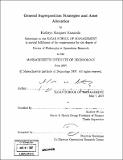| dc.contributor.advisor | Andrew W. Lo. | en_US |
| dc.contributor.author | Kaminski, Kathryn Margaret | en_US |
| dc.contributor.other | Massachusetts Institute of Technology. Operations Research Center. | en_US |
| dc.date.accessioned | 2008-02-27T22:18:19Z | |
| dc.date.available | 2008-02-27T22:18:19Z | |
| dc.date.copyright | 2007 | en_US |
| dc.date.issued | 2007 | en_US |
| dc.identifier.uri | http://hdl.handle.net/1721.1/40384 | |
| dc.description | Thesis (Ph. D.)--Massachusetts Institute of Technology, Sloan School of Management, Operations Research Center, 2007. | en_US |
| dc.description | Includes bibliographical references (p. 139-150). | en_US |
| dc.description.abstract | Investors commonly use stopping rules to help them get in and out of their investment positions. Despite their widespread use and support from behavioral finance, there has been little discussion of their impact on portfolio performance in classic portfolio choice theory. In this thesis, I remedy this situation by discussing the performance impact of stopping rules, highlighting the stop-loss rule. Stop-loss rules-predetermined policies that reduce a portfolio's exposure after reaching a certain threshold of cumulative losses-are commonly used by retail and institutional investors to manage the risks of their investments, but have also been viewed with some skepticism by critics who question their efficacy. I develop a simple framework for measuring the impact of stop-loss rules on the expected return and volatility of an arbitrary portfolio strategy, and derive conditions under which stop-loss rules add or subtract value to that portfolio strategy. I show that under the Random Walk Hypothesis, simple 0/1 stop-loss rules always decrease a strategy's expected return, but in the presence of momentum, stop-loss rules can add value. To illustrate the practical relevance of this framework, | en_US |
| dc.description.abstract | (cont.) I provide an empirical analysis of a stop-loss policy applied to a buy-and-hold strategy in U.S. equities, where the stop-loss asset is U.S. long-term government bonds. Using monthly returns data from January 1950 to December 2004, I find that certain stop-loss rules add 50 to 100 basis points per month to the buy-and-hold portfolio during stop-out periods. By computing performance measures for several price processes, including a new regime-switching model that implies periodic "flights-to-quality," I provide a possible explanation for our empirical results and connections to the behavioral finance literature. Consistent with the traditional investor's problem, I discuss a generalization of this approach to general stopping rules, which are superimposed on arbitrary portfolio strategies. I define a stopping utility premium and discuss how uncertainty about the true stochastic process can explain a potential value added or value lost by the use of stopping rules in practice. | en_US |
| dc.description.statementofresponsibility | by Kathryn Margaret Kaminski. | en_US |
| dc.format.extent | 150 p. | en_US |
| dc.language.iso | eng | en_US |
| dc.publisher | Massachusetts Institute of Technology | en_US |
| dc.rights | M.I.T. theses are protected by copyright. They may be viewed from this source for any purpose, but reproduction or distribution in any format is prohibited without written permission. See provided URL for inquiries about permission. | en_US |
| dc.rights.uri | http://dspace.mit.edu/handle/1721.1/7582 | |
| dc.subject | Operations Research Center. | en_US |
| dc.title | General superposition strategies and asset allocation | en_US |
| dc.type | Thesis | en_US |
| dc.description.degree | Ph.D. | en_US |
| dc.contributor.department | Massachusetts Institute of Technology. Operations Research Center | |
| dc.contributor.department | Sloan School of Management | |
| dc.identifier.oclc | 191106918 | en_US |
